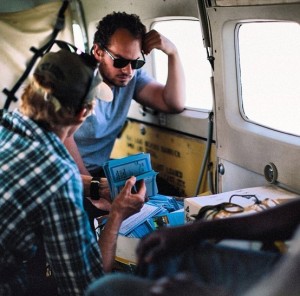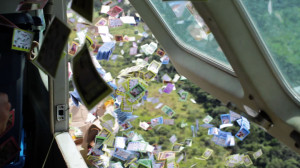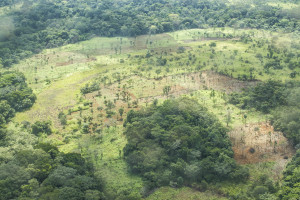Reports from our Early Warning Network have shown a surge in LRA attacks in Nambia-Ngbangala, a village in the Haut-Uele district of the Democratic Republic of Congo (DRC). Invisible Children’s counter-LRA experts collected the reported information then analyzed it to share with partners and other counter-LRA actors in the region. Here’s what they’ve found:
During the first few weeks of February there was a surge of reported LRA activity near the village of Nambia-Ngbangala in the Haut-Uele district of DRC. Between February 2nd -25th there were seven reported LRA attacks within 20km of the village resulting in the abduction of at least six individuals from the area. Additionally, there have been three separate occasions when civilians have encountered LRA in the Nambia-Ngbangala area including two hunters who reported seeing a large group of LRA at a camp just 20km north of the village.
The cause of these attacks and increased activity has primarily been in order to loot food and other supplies.(Stolen property includes: corn, paddy, tools, boots, clothes, utensils, hunting rifles, and ammunition.) This LRA group’s frequent looting is likely linked to the general vulnerability of LRA groups in DRC following AU-RTF (African Union Regional Task Force) military operations in late 2013. Additionally, current dry season climate makes it difficult to gather food or carry out small-scale cultivation this time of the year.
So, what does this all mean? I talked to Invisible Children’s Counter-LRA Programs Manager, Sean Poole, to find out.
So can you break this upsurge in activity down for us? What’s causing the recent upswing in attacks in the Nambia-Ngbangala area?

Well, the overarching trend is that there has been a 44% decrease in LRA activity between 2012-2013 largely as a result of the AU-RTF mission and effective measures to improve communication between communities around LRA movements, like the Early Warning Network. But what we’re seeing in DRC since the beginning of this year [2014] is that what is likely a small group of LRA—approximately 10% of the entire LRA force—has continued to operate in DRC. Now, this group may be there because pressure from counter-LRA forces in CAR [Central African Republic] have pushed this group south, or this may simply be a small group that has stayed in this area to maintain a presence in what has been a historically strategic area for the LRA.
But here’s what’s key to all of this: the cause of this activity is as basic as the LRA needing food to survive. They’ve been able to use DRC for the past few years to grow food on a large scale, but in the latter half of 2013 offensive operations by the AU-RTF successfully destroyed areas that the LRA were using to cultivate food. Because these farms previously supplied a lot of the LRA’s food, they now have resorted to attacking communities to gain access to food. This is especially the case between February-April when dry season regionally limits the availability of wild crops that can be gathered and sustain LRA groups.
Got it. But what I’m hearing is that destroying LRA camps and food supplies has just resulted in more attacks on civilians?
Destroying LRA camps and strategic areas of operation are critical to any strategy to end their threat to civilians. When you destroy their camps, you make them less comfortable thereby increasing LRA defections and forcing them to move more regularly making it easier for LRA forces to find them in the vast area of operation in Central Africa. To complement this strategy, however, what we really need to happen now is concerted efforts to protect civilians in light of a more desperate LRA force. We’ve seen this same desperation all over the region including recently in Obo, CAR when a LRA group risked attacking civilians in a town with both UPDF (Ugandan military) and US Special forces installations. LRA groups are willing to attack populated areas likely because of their desperation and need for food and supplies.
If the LRA in DRC is so desperate, why are they still there instead of CAR or South Sudan? I mean aren’t most of the LRA force taking advantage of the political chaos CAR anyways?
Yes, but again only 10% of the LRA is in DRC right now, which is a very small portion. They’ve been forced to abandon the camps they’ve been using for a long time which means that the remaining groups in DRC are now smaller an more mobile—and therefore relatively difficult for counter-LRA actors to find.
But more critically, DRC is familiar territory for the LRA. There has been a LRA operation there since 2006 and has since then been a strategic location for the LRA. Additionally, because of the locations of AU-RTF security forces, there is less day-to-day threat to LRA in DRC.
So then what will it take to rid DRC of LRA once and for all?
 To be honest, this will not occur until the region is free from LRA threat. DRC will remain strategic and will always be used as a safety valve when counter-LRA operations in CAR put pressure on the LRA. Counter-LRA forces need to get better at working with local populations to collect information for this to happen— chasing down leads by plane is a lot more ineffective than using local populations to feed information on LRA movements. We need to continuing to prioritize defections of LRA combatants, which not only reduce the LRA’s overall number of fighters, but provides invaluable intelligence on LRA movements and changes in LRA strategy.
To be honest, this will not occur until the region is free from LRA threat. DRC will remain strategic and will always be used as a safety valve when counter-LRA operations in CAR put pressure on the LRA. Counter-LRA forces need to get better at working with local populations to collect information for this to happen— chasing down leads by plane is a lot more ineffective than using local populations to feed information on LRA movements. We need to continuing to prioritize defections of LRA combatants, which not only reduce the LRA’s overall number of fighters, but provides invaluable intelligence on LRA movements and changes in LRA strategy.
+++
What else will it take to ‘rid DRC of the LRA once and for all?’ You. Because of your support, Invisible Children is able to continue vital protection and defection programs across central Africa. Thank you for working with us to finally achieve peace in LRA-affected areas of DRC, CAR and South Sudan.


Think people should hear about this?